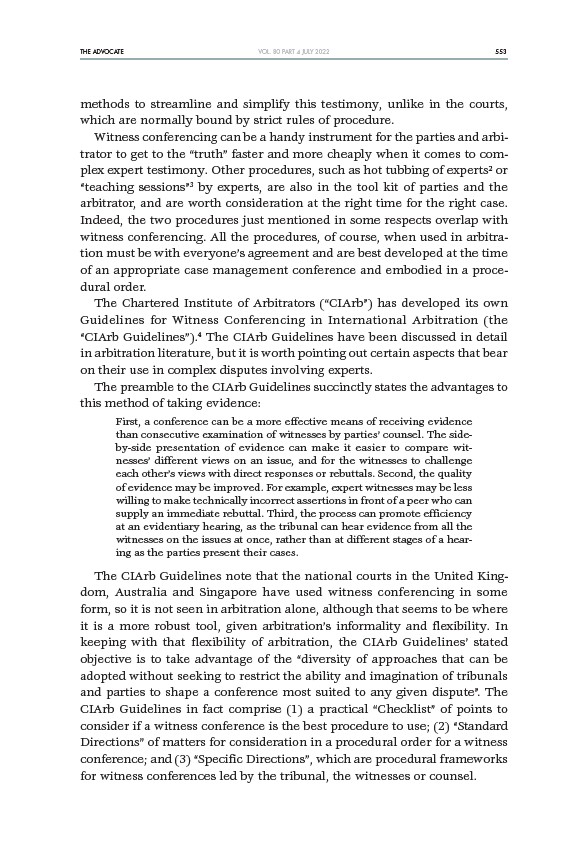
THE ADVOCATE 553
VOL. 80 PART 4 JULY 2022
methods to streamline and simplify this testimony, unlike in the courts,
which are normally bound by strict rules of procedure.
Witness conferencing can be a handy instrument for the parties and arbitrator
to get to the “truth” faster and more cheaply when it comes to complex
expert testimony. Other procedures, such as hot tubbing of experts2 or
“teaching sessions”3 by experts, are also in the tool kit of parties and the
arbitrator, and are worth consideration at the right time for the right case.
Indeed, the two procedures just mentioned in some respects overlap with
witness conferencing. All the procedures, of course, when used in arbitration
must be with everyone’s agreement and are best developed at the time
of an appropriate case management conference and embodied in a procedural
order.
The Chartered Institute of Arbitrators (“CIArb”) has developed its own
Guidelines for Witness Conferencing in International Arbitration (the
“CIArb Guidelines”).4 The CIArb Guidelines have been discussed in detail
in arbitration literature, but it is worth pointing out certain aspects that bear
on their use in complex disputes involving experts.
The preamble to the CIArb Guidelines succinctly states the advantages to
this method of taking evidence:
First, a conference can be a more effective means of receiving evidence
than consecutive examination of witnesses by parties’ counsel. The sideby
side presentation of evidence can make it easier to compare witnesses’
different views on an issue, and for the witnesses to challenge
each other’s views with direct responses or rebuttals. Second, the quality
of evidence may be improved. For example, expert witnesses may be less
willing to make technically incorrect assertions in front of a peer who can
supply an immediate rebuttal. Third, the process can promote efficiency
at an evidentiary hearing, as the tribunal can hear evidence from all the
witnesses on the issues at once, rather than at different stages of a hearing
as the parties present their cases.
The CIArb Guidelines note that the national courts in the United Kingdom,
Australia and Singapore have used witness conferencing in some
form, so it is not seen in arbitration alone, although that seems to be where
it is a more robust tool, given arbitration’s informality and flexibility. In
keeping with that flexibility of arbitration, the CIArb Guidelines’ stated
objective is to take advantage of the “diversity of approaches that can be
adopted without seeking to restrict the ability and imagination of tribunals
and parties to shape a conference most suited to any given dispute”. The
CIArb Guidelines in fact comprise (1) a practical “Checklist” of points to
consider if a witness conference is the best procedure to use; (2) “Standard
Directions” of matters for consideration in a procedural order for a witness
conference; and (3) “Specific Directions”, which are procedural frameworks
for witness conferences led by the tribunal, the witnesses or counsel.